More than 700 students submitted over 300 individual and team research projects to present at the annual Stander Symposium on April 22, 2021. Students chose to share their research in a variety of ways: downloadable posters and papers; live presentations on Zoom; recorded presentations; and safe-distance live presentations from front porches and other locations on campus. Browse the gallery below or search for specific research projects using the search function at the top left of the screen.
This gallery contains projects from the 2021 Stander Symposium by students, faculty and staff in the School of Business Administration
-

MGI International LLC
Erin Marie Cavrak, Jack Mcguire, Jack William Purcell, Ashley M. Shaffer
CRM Development & Launch New York, NY
-

"North American Properties Struxtion"
Jacqueline J. Chmiel, Patrick J. Hart, John Corrigan Roberts, Joe Tyler Vogrin
ERP Build vs Buy vs Hybrid Analysis and Recommendation
-

Ohio's Hospice Inc.
Alex Thomas Costa, Joshua Newman, Conner J. Templin, Sarah K. Thompson
"Business Intelligence/Visualization System..replace Power BI"
-

Openly HQ
Maureen Barbara Deering, Brandon Richard Donase, Jacob Levin
"Sports Review Platform - startup Enhance System Reporting Capability"
-

Rittal
Emily M. Anteau, Jared Michael Beach, Benjamin McKiernan Blincoe, Maya Elizabeth Gerker, Laura J. Harris
Internal Material Logistics Optimization
-

Rittal
Nathan R. Kravchuk, Benjamin David Michaud, Edward Flint Warda, Nolan Patrick Yager
Dir (Special Order) Process Optimization
-

STEM Kids NYC
Sarah Elizabeth Angeloff, Matthew D. Brenneman, Nathan J. Campbell, Kevin Padraic Cavanaugh
Development Scheduling System of sTEM Kids, Teaching Resources, and Facilities
-

Stock Returns and Safe Interest Rates: An Empirical Analysis, 2001 – 2019
Fouad O. Saleh
Stock Returns and Safe Interest Rates: An Empirical Analysis, 2001 – 2019Modern Finance Theory postulates that the intrinsic value of a firm's publicly traded common stock is equal to the discounted value of future cash flows or dividends. Holding cash flows constant, the intrinsic value depends on the interest rate at which the cash flows are discounted. A rise in the discount rate lowers the intrinsic value while a decrease in the discount rate increases the intrinsic value.In this study, I looked at the empirical relationship between intermediate and long-term treasury rates and the stock market as measured by the S&P 500 index. The period of analysis is 2001 – 2019 with a special focus on the empirical relationship pre and post 2008 recession. I use univariate regression analysis with the S&P 500 Index, or SPY, (in logs) as the Y variable and the intermediate (Treasury Notes) and Long-term (Treasury Bonds), also in logs, as the x variables. The hypothesis tested:1.The regression slope coefficients are statistically significant at the 95% confidence levels2.There is a recession effect i.e., the pre and post 2008 recession, slope coefficients are significantly different3.Since the long-term trend in treasury rates is downward sloping, the slope coefficients are positive i.e., lowering the discount rate results in rising stock prices.
-

Stock Returns in Selected S&P 500 Sectors during the COVID-19 Pandemic
William Edward Bronsil, John Richard Coffey, Mary Bliss Stitzel
In mid-February 2020, the stock market declined sharply due to the COVID-19 pandemic. In late March 2020, many stocks bottomed out and the market started a first stage rebound that ended in August 2020. In this study we selected the top ten stocks (by market value) in the S&P 500 consumer discretionary sector to measure their rate of decline and rebound for the above period of time. Using time trend regressions we take the regression slope coefficients as the rates of growth measure and then develop an uptrend/downtrend growth ratio which acts as a portfolio weight for each of the ten stocks. We then test the following hypotheses: (1) The higher the growth ratio the higher the return for a given stock thru the end of 2020. (2) As a portfolio of stocks with the growth ratio as the principal factor loading, the portfolio return out performs the market return thru 2020. (3) The ten stock portfolio shows persistence in returns throughout 2020.



